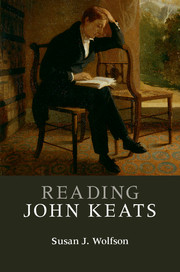Book contents
- Frontmatter
- Dedication
- Contents
- List of figures
- Preface
- Acknowledgments
- Note on the texts
- List of abbreviations
- 1 Life and times
- 2 Conceiving early poems, and Poems
- 3 Falling in and out of love with Endymion: A Poetic Romance; rereading King Lear
- 4 Venturing “new Romance”: Isabella; or, The Pot of Basil. A STORY FROM BOCCACCIO
- 5 Falling with Hyperion
- 6 Still Romancing: The Eve of St. Agnes; a dream-sonnet; Labelle dame
- 7 Reforming the sonnet and forming the Odes of spring 1819: Psyche; Nightingale; Grecian Urn; Melancholy; Indolence
- 8 Writhing, wreathing, writing Lamia
- 9 Falling in Fall 1819: The Fall of Hyperion and To Autumn
- 10 Late poems & lasting Keats
- A few famous formulations
- At a glance: Keats in context
- Notes
- Further reading
- Index
Preface
Published online by Cambridge University Press: 05 June 2015
- Frontmatter
- Dedication
- Contents
- List of figures
- Preface
- Acknowledgments
- Note on the texts
- List of abbreviations
- 1 Life and times
- 2 Conceiving early poems, and Poems
- 3 Falling in and out of love with Endymion: A Poetic Romance; rereading King Lear
- 4 Venturing “new Romance”: Isabella; or, The Pot of Basil. A STORY FROM BOCCACCIO
- 5 Falling with Hyperion
- 6 Still Romancing: The Eve of St. Agnes; a dream-sonnet; Labelle dame
- 7 Reforming the sonnet and forming the Odes of spring 1819: Psyche; Nightingale; Grecian Urn; Melancholy; Indolence
- 8 Writhing, wreathing, writing Lamia
- 9 Falling in Fall 1819: The Fall of Hyperion and To Autumn
- 10 Late poems & lasting Keats
- A few famous formulations
- At a glance: Keats in context
- Notes
- Further reading
- Index
Summary
“The poetry of earth is never dead,” wrote Keats in the dead of winter. Let's say the same about the poetry of John Keats (1795–1821). It flourishes in edition after edition, on the walls of libraries and reading rooms, in book titles and popular songs, and in phrases we all know: “A thing of beauty is a joy for ever” “tender is the night” “alien corn” “Beauty is truth; truth Beauty” “season of mists and mellow fruitfulness” “fanatics have their dreams.” What if this talented young man had had the means to attend a university? He would have been a star student: vigorously underlining and annotating, eager to talk about his reading, rereading constantly, and probably petitioning for an interdisciplinary program in literature, philosophy, and medicine. Keats was a voracious reader, lived in books he said, had read Hamlet forty times (from his ease of reference, it's clear he had much of Shakespeare by heart). His letters bristle with his reading, not only in reports but in their very metaphors, figured as books, passages, and reading itself (“dark Passages” the heart as a “horn-book”). He began writing poetry in his teens, with Imitation of Spenser (he read the entire Faerie Queene, a feat few professors today may claim); one of his first publications was a sonnet written after an all-nighter with George Chapman's 1616 translation of Homer's Iliad and Odyssey. To firm up his vocation, he sat down to reread Shakespeare's fiercest tragedy, King Lear – and wrote a sonnet on this event, too. Keats's poetry often pivots on events of reading – by turns, passionate, careful, interpretive, skeptical. Great literature, Keats knew, is intellectual vigor with aesthetic complexity, and it always rewards concentrated reading.
Keats-the-reader is also a critical rereader, and the lively density of his own poetry repays such attention. In Reading John Keats I attend to the actions of Keats's language and to how these activate our reading. Reading John Keats provokes us to reflect on what it is to read, fail to read, misread, reread, read better.
- Type
- Chapter
- Information
- Reading John Keats , pp. x - xivPublisher: Cambridge University PressPrint publication year: 2015



